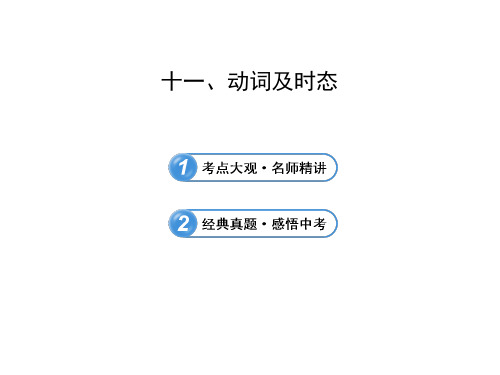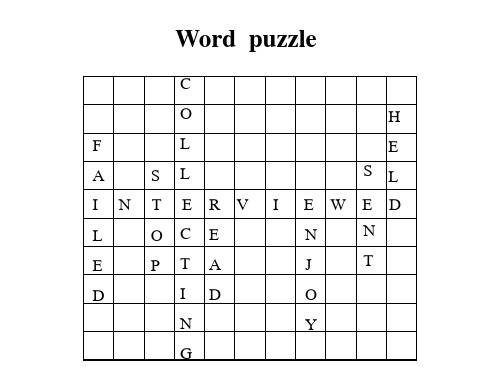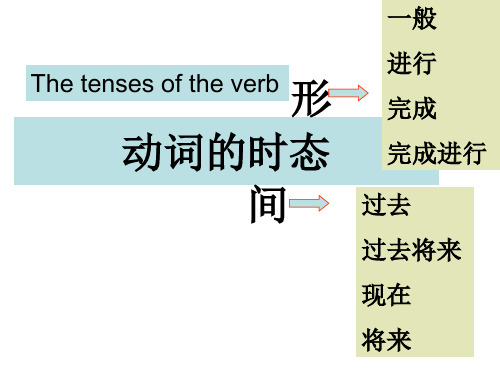初中英语语法动词时态pptPPT课件
合集下载
初中英语语法动词及时态ppt课件

过去进行时 主语+was/were+v. -ing+其他
现在完成时 主语+have/has+过去分词+其他
中学阶段见到的其他时态 时态
构成
过去完成时 主语+had+过去分词+其他
过去将来时
现在完成 进行时
主语+would+动词原形+其他 主语+was/were going to+动词原形
主语+have/has+been+现在分词+其他
状语
【温馨提示】
(1)在含有时间状语从句的复合句中,延续时间较长的动作用过 去进行时,另一个短暂性动作用一般过去时。例如:
My pen dropped on the ground when I was walking in the park. 在公园散步的时候,我的钢笔掉到地上了。
(2)表示两个延续性动作在过去某一时刻同时进行,不考虑动作 的先后顺序,主句和从句的谓语动词都用过去进行时,连词常 用while。例如:
词
宾语,又分为及物动词和 不及物动词。
物动 run , walk , cry , 词 swim,fall,happen
连
系 连接主语和表示主语身份、be , seem , look , become ,
动
性质、状态的动词称为连 get , grow , feel , appear ,
系动词。
turn
day等频率副词或时间状语 month.
连用
我们每月都去看望刘叔叔。
用法
例句
表示客观事实或普遍真理 The sun rises in the east. 太阳在东方升起。
初中英语语法动词时态ppt精品课件

3.e.g. Do you see a plane in the sky?
4. 注意:1) feel 可以用一般时和进行时表示说话
时的感觉:
5. e.g. I am not feeling well today.
6.
How are you feeling today?
7.
I feel tired.
8.
e.g. He was writing a composition last night.(作文不一定完成) He wrote a composition last night.(作文肯定 写完了)
(5) 现在完成时 I. 构成: have / has + 动词的过去分词 II. 用法:
1. 表示说话前某一个时刻发生的动作之结果对现 在的影响。
e.g. I hope you will enjoy your meal.
I want to visit them tomorrow.
4. 当有些感觉动词词义转变,成为表示动作的动词 时,可以用进行时: e.g. Now I see the liquid in the glass has turned red.
e.g. He was doing shopping this time yesterday. We were having a discussion at that time. 2. 表示过去某一阶段正在进行的动作. 1. e.g. Peter was playing chess the whole
4. 用与时间或条件状语从句中, 代替一般将来时: e.g. I will be happy if you all come. We will go when he comes.
初中英语八种时态归纳PPT

10. About 400 years ago, Galileo proved that the earth travels (travel) around the sun.
Part B 语态
Active Voice
Passive Voice
主动语态
1. Many people speak English.
At the party.
--- I _l_ik_e___ your jacket, Tim. How long _h_a_v_e_y_o_u__h_a_d__ it?
Oh…er… I __b_o_u_g_h_t__it last week. W__o_u_l_d_y_o_u__li_k_e_ to dance, Becky? ---Phew. It’s __h_o_t__ here. --- Put your jacket on the chair. You ____n_e_e_d_n’wt orry. It’ll be ok. ---That’s _b_e_tt_e_r __.
8. Mr. Green and his wife had lived (live) in London for a few years before they came (come) to work in China in 2001.
9. He said he w__o_u_ld__n_o_t_s_p_e_a(k not,speak) at the meeting the next day.
4. Hurry! Your classmates _a_r_e_w__a_it_i_n_g(wait) for you in the classroom..
1. This is the third time you _h_a_v_e__b_e_e_n__(be) here.
Part B 语态
Active Voice
Passive Voice
主动语态
1. Many people speak English.
At the party.
--- I _l_ik_e___ your jacket, Tim. How long _h_a_v_e_y_o_u__h_a_d__ it?
Oh…er… I __b_o_u_g_h_t__it last week. W__o_u_l_d_y_o_u__li_k_e_ to dance, Becky? ---Phew. It’s __h_o_t__ here. --- Put your jacket on the chair. You ____n_e_e_d_n’wt orry. It’ll be ok. ---That’s _b_e_tt_e_r __.
8. Mr. Green and his wife had lived (live) in London for a few years before they came (come) to work in China in 2001.
9. He said he w__o_u_ld__n_o_t_s_p_e_a(k not,speak) at the meeting the next day.
4. Hurry! Your classmates _a_r_e_w__a_it_i_n_g(wait) for you in the classroom..
1. This is the third time you _h_a_v_e__b_e_e_n__(be) here.
初中英语中考复习时态讲解课件(共79张ppt)

一般现在时
1. 表示经常性或习惯性的动作
She does excersice everyday.
真题链接
—What do you often do at weekends?
—I often ____ my grandparents.
A. visit
B. visited
C. have visited D. will visit
Just a moment, I am washing dishes.
when
习题
Just a minute! My brother________ his car in the garden. A. washes B. is washing C. washed D. will wash
习题
---Hey, Tom. Let’s go swimming.
动词过去分词 不规则变化
speak hear see give build swim buy teach
spoken heard seen given built swum bought taught
现在完成时
already yet
1.过去发生或已完成的某一动作对现在的影响。
I have already watched this film. I haven't watched this film yet. I have already visited America. I haven't visited America yet.
A. prepares
B. is preparing
C. has prepared D. prepared
真题链接
--Mum, it's late. Why are you still here? --Dad hasn't come back yet. I ____ for him. A. am waitingB. was waiting C. waited D. had waited
2024年中考英语复习第十章:动词的时态和语态课件

在看电视。 2. 过去进行时常与always等表示频率的副词连用,表示过去频繁发生的习惯性动作。此 时的过去进行时有一点的感情色彩。 • Alice was always changing her mind. 爱丽丝总是改变主意。 时间状语:this morning, the whole morning, all day ,yesterday, from nine to ten
5. 对现在进行时的特殊疑问句的回答,它不可以用Yes或No直接作答,要根据实际
情况回答。
• -Yes,he is.是的。
-No,he isn't.不是。
现在进行时
现在分词的变化 1. 动词的后面直接加-ing。 • work-working,study-studying, play-playing 2. 以不发音的字母e结尾的动词,先去掉字母e,再加-ing。 • live-living 3. 以重读闭音节结尾并且只有一个辅音字母的动词,先双写这个辅音字母,再加- ing。 • stop-stopping,swim-swimming,run-running, get-getting
现在进行时
现在进行时的句式变化:
1. 肯定句式:主语+be( am, is, are)+现在分词+其它.
• Li Hua is cleaning the classroom.李华在打扫教室
2. 否定句式:主语+be(am, is, are) +not +现在分词+其它.
• Li Hua isn't cleaning the classroom.李华不是在打扫教室,
04
过去进行时
过去进行时
用法
5. 对现在进行时的特殊疑问句的回答,它不可以用Yes或No直接作答,要根据实际
情况回答。
• -Yes,he is.是的。
-No,he isn't.不是。
现在进行时
现在分词的变化 1. 动词的后面直接加-ing。 • work-working,study-studying, play-playing 2. 以不发音的字母e结尾的动词,先去掉字母e,再加-ing。 • live-living 3. 以重读闭音节结尾并且只有一个辅音字母的动词,先双写这个辅音字母,再加- ing。 • stop-stopping,swim-swimming,run-running, get-getting
现在进行时
现在进行时的句式变化:
1. 肯定句式:主语+be( am, is, are)+现在分词+其它.
• Li Hua is cleaning the classroom.李华在打扫教室
2. 否定句式:主语+be(am, is, are) +not +现在分词+其它.
• Li Hua isn't cleaning the classroom.李华不是在打扫教室,
04
过去进行时
过去进行时
用法
初中英语动词的时态和被动语态(共14张PPT)

延续性动词 be on be at/in+地点 be at/in+地点 be in/a member of be on have know keep
have a cold
have been to—have gone to
曾经去过(主语人在) 已经去了(主语人不在)
--I can’t find you these days.Where have you been?
be over be up be back be away (from) be here /there
非延续性动词 put on come/go to arrive/reach/get to join begin/start buy get to know borrow / lend
catch a cold
定义 表示过去某时间或某动作以前发生的动作。
结构 关健字
S+had+V过去分词
IwSr+heheaanlidzIner’det+aIVchh过ae去dd分let词hftemcoyupHnutar.sde+Sa+t Vh过om去分e词
by the time I came back,by the end of last term, when I got to the station,before he went to bed
表示过去某时刻或某阶段正在发生的动作。
was
1.SW+hawtawsna’st /hwe edroein’gt dwohinegn the UFO arrived?
结构 S+ weredoing 2W. Tahse/yWweerree+hSav+idnoginfugn…th?ese days.
初中英语语法动词PPT课件

e.g. I saw him today.
He came late three times this week.
练习
返回
一般过去时的练习
1. I saw him this morning.(改为否定句、疑问句并做回答)
2. He came late three times this week.(同上)
5.Where is Mak? He___________(run) on the grass.
6. Listen, who____________(sing) in the music room? Oh, Mary_____________(sing) there.
7.The birds are singing in the tree.(就划线部分提问). 8.The children are playing games near the house.(就划线部分提问) 9.The Young Pioneers are helping the old woman.(改成一般疑问句)
He wrote a letter to me last month. 过去时态
We study English.主动 The road was filled with rubbish. 被 动
He has flown to America. 事实 I wish I could fly to the moon some day. 愿望
如arrive, come, go, leave, move, start, stay, get等)
d.be + 动词不定式 (例:You are to be back before 10:00 p.m..
初中英语语法—时态(28张) PPT课件 图文

(4)现在完成时与表示一段时间的for短语、since短语或从句等 时,应注意句中的谓语动词须是延续性的,而不能是非延续性动词,如 come→be here,go→be there,die→be dead,borrow→keep,buy→h ,join→be in,leave→be away,begin to study→study等。
6.过去进行时
(1)概念:表示过去某一时刻或某一时间段内正在进行的动作。 (2)构成形式:was/were+动词的-ing形式 ①表示往返、位移的动词的过去进行时常可用来表示过去将来时
时态 We wanted to tell her that the train was_leaving an hour later.
1.一般现在时
基本用法: (1)表示经常性、习惯性的动作; He always helps others. 他总是帮助别人。
时态 (2)表示现在的情况或状态;
He is a teacher. 他是个老师。 (3)表示客观事实和普遍真理。 The sun rises in the east. 太阳从东边升起。 构成形式:am/is/are或实义动词的原形(主语是第三人称单数时,动 词要用第三人称单数形式)。
时态 (2)构成形式:have/has+动词的过去分词。
(3)与现在完成时连用的时间状语有for a long time,recently,yet, lately,ever,never,already,since,by this time,before,just,in t past/last few years,since+过去的时间点,since+时间段+ago,since +从句(一般过去时)。
表示感觉的动词。如:see,hear等。 表示喜欢或厌恶的动词。如:like,love等。 表示希望的动词。如:want,would like等。
- 1、下载文档前请自行甄别文档内容的完整性,平台不提供额外的编辑、内容补充、找答案等附加服务。
- 2、"仅部分预览"的文档,不可在线预览部分如存在完整性等问题,可反馈申请退款(可完整预览的文档不适用该条件!)。
- 3、如文档侵犯您的权益,请联系客服反馈,我们会尽快为您处理(人工客服工作时间:9:00-18:30)。
8. 7. – What has happened to the fish, Mary?
9. -- Mum, the chaat s__e_a_te_n_ (eat) the fish. Just now
the jcuamt _p_e_d__(jump) onto the table anadte_____(eat)
He is seeing his friend off at the airport.
I think they will come. We are all thinking hard.
The report shows the problem is serious. He is showing them around our school.
4. 注意:1) feel 可以用一般时和进行时表示说话
时的感觉:
5. e.g. I am not feeling well today.
6.
How are you feeling today?
7.
I feel tired.
8.
2) see, hear 有相应表示动作的动词 look
at / listen to , 这些词可以用进行时
8
___(grow) taller.
got
(3) 一般过去时
1.表示过去某一具体时间发生过的动作.
2. e.g. I reviewed my lessons last night.
3.
注意: 1)有时句中虽然没有表示确定过
feel(认为), fit(合适), find(认为), show(表明),
have(有)
e.g. I hope you will enjoy your meal.
I want to visit them tomorrow.
2021/3/7
CHENLI
6
4. 当有些感觉动词词义转变,成为表示动作的动词 时,可以用进行时: e.g. Now I see the liquid in the glass has turned red.
10.3. 表示客观真理,谚语,格言.
2021/3/7
CHENLI
3
11. e.g. The sun sets in the west.
4. 用与时间或条件状语从句中, 代替一般将来时: e.g. I will be happy if you all come. We will go when he comes.
2021/3/7
CHENLI
5
比较: Do you see a map on the wall?
He is looking at a map on the wall.
I hear a strange Nhomakorabeaoise from the car engine.
He is listening to the music.
动词时态
2021/3/7
CHENLI
1
初中阶段8种时态:
1.一般现在时
2.一般过去时
3.一般将来时
4.现在进行时
5.过去进行时
6.现在完成时
7.过去完成时
8.过去将来时
2021/3/7
CHENLI
2
(1) 一般现在时:
1.表示经常反复发生的动作.
2. e.g. They often spend their holidays in
3. 有些表示状态或心理感觉的动词一般不用现在
进行时,而用一般现在时表示状态或感觉,如
love, like, hate, want, need, wish, know(知道),
understand(懂得), remember(记得), believe,
guess(认为), mean(意味着), think(认为),
it up. lived
10.8. Sam ____( live) in the small town fhoarvfievegryoewanrs
during the war.
saw
11.9. It is ages since I last ____(see) you. You
2021/3/7
CHENLI
the south.
3.
常搭配的时间状语:
4. always often usually sometimes
5. seldom never from time to time
6. now and then (偶尔) every day
every ….
7. once a week
8.2.表示状态:
9. e.g. He is busy at the moment.
2021/3/7
CHENLI
7
Exercise:
1. Water f_r_e_e_ze_s_(freeze) at the temperature 0.
2. The air _k_e_e_p_s( keep ) moving all the time.
3. The town _l_ie_s__( lie) to the west of the hill. 4. I _b_e_l_ie_v_e_( believe) you _a_re__te_l_li_n_gtell the truth now.
5. -- __I_s_ my son __w_o_r_k_in_g___ (work) hard this term?
6. -- Oh, yes, he _is__tr_y_i_n_g__(try) his best now.
7. 6. D__o_e_s__ the hatfi_t______ (fit) me well?
(2) 现在进行时 1.表示说话时正在进行的动作.
2. e.g. He is walking towards the plane. 3.2. 表示目前一阶段正在进行(但说话时不一定在
进行)的动作:
4. e.g. We are writing a paper these days.
2021/3/7
CHENLI
4
一般现在时与现在进行时的区别
1.进行时强调动作正在进行,而现在时强调动作的
经常和反复,或特征,这类动作没有时间性的.
2.某些表示感官知觉的动词如: see, hear, smell,
taste等表示感觉,用一般时,不用进行时.
3.e.g. Do you see a plane in the sky?
